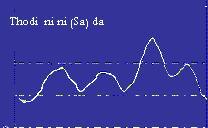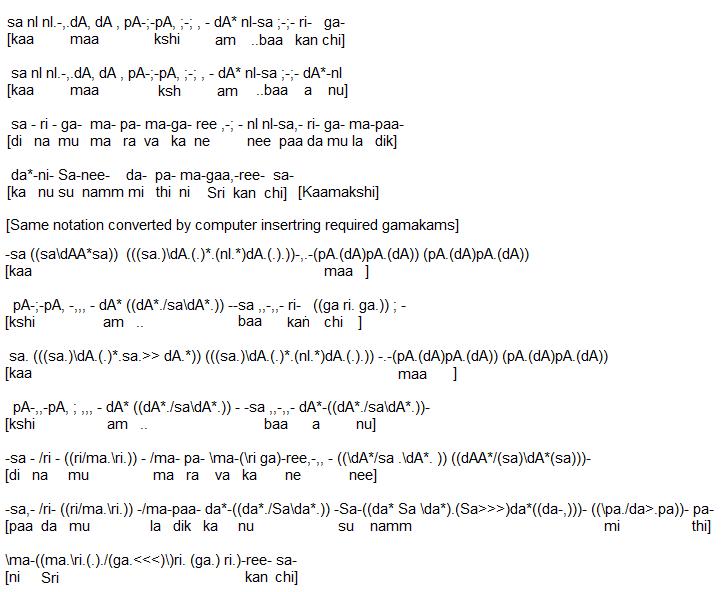
|
|
|
Gamakam - Some Links Gamakam symbols in Sangeetha Sampradaya Pradarsinni Computer Analysis of Gamakams of Mayamalavagowla Computer Analysis of Gamakams of Thodi
Carnatic Music Software (including Gaayaka) - using Gamakams
Arun Kumar's Java applet for Carnatic Gamakam (Midi format) |
As the Gaayaka program will play only what is entered, it becomes necessary for the user to enter the notation for nuances in detail. An example is the (carnatic) suddha rishabham which is often played by oscillation from the lower note shadjam. For the notation written as 'sa ri ga' the note 'ri' is sung as 'saa ri saa ri saa' with sa taking most of the time and ri being touched quickly. The note kaisiki nishadham when prolonged in ragams having chatusruthi dhaivatham is often oscillated upto the shadjam from the dhaivatham. The gamakam used in a note not only depends upon the individual ragam but also its context and duration. A program has been written by me to convert the bare notation (in Gaayaka format) into one having the natural nuances of the ragam. My paper describing the issues involved in such a conversion has been published in 'Sangeet Natak'.Volume XLIII, No.3,2009 pp.28-36. (I can send a copy of this paper to any interested reader). . Some examples of the music generated from bare notation and the music generated from the converted notation are put up here. You can download the 'AddGamakam' conversion program and the newer version of Gaayaka (Gka7.exe) and try it. The newer version of Gaayaka is part of the next version of Rasika package. It has the facility to easily exchange alternative gamakam notations generated by the AddGamakam program. Click here to go to the download and instructions page The experience in using the program (at its presents state of development) shows that where the notation accurately describes the basic outline of the music (as in the case of Varnams) the result of the music from the computer converted notation is quite close to the sung music. The following clips were generated from Gaayaka which enables any notation to be saved as a .wav file. The .wav files were then converrted to .mp3 files. Examples below include Varnam and Krithis. Click here to see samples of plain notation and the computer converted notations are given at the end of this page 1. Adi thala Varnam in ragam Sankarabharanam (upto Anupallavi)
2. Pallavi of Syama Sasthri's Krithi Sarojadhalanethri in Sankarabharanam
3. Bhairavi Swarajati of Syama Sasthri - (upto 4 charanams)
4. Pallavi and Anupallavi of Papanasam Sivan's Krithi Kanthimathi in Kanada
|


